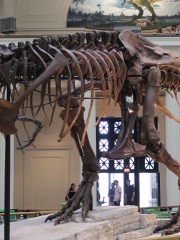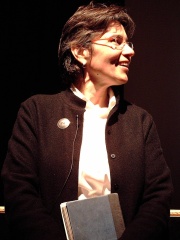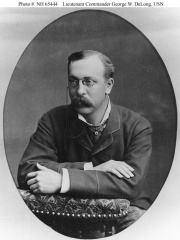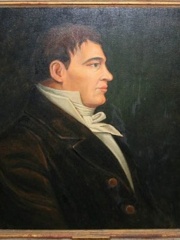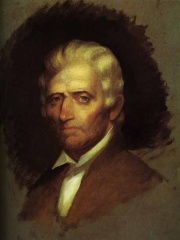
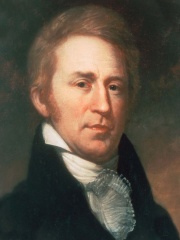
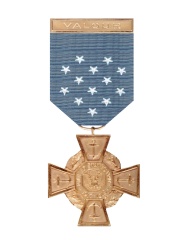
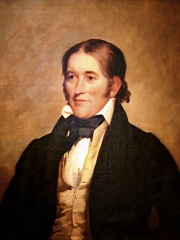
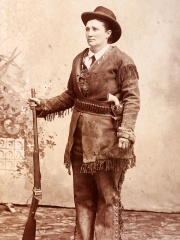
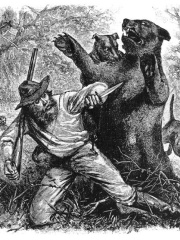
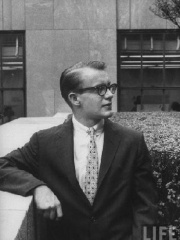

The Most Famous
EXPLORERS from United States
This page contains a list of the greatest American Explorers. The pantheon dataset contains 498 Explorers, 39 of which were born in United States. This makes United States the birth place of the 3rd most number of Explorers behind United Kingdom, and Spain.
Top 10
The following people are considered by Pantheon to be the top 10 most legendary American Explorers of all time. This list of famous American Explorers is sorted by HPI (Historical Popularity Index), a metric that aggregates information on a biography's online popularity. Visit the rankings page to view the entire list of American Explorers.

1. Daniel Boone (1734 - 1820)
With an HPI of 73.46, Daniel Boone is the most famous American Explorer. His biography has been translated into 34 different languages on wikipedia.
Daniel Boone (November 2 [O.S. October 22] 1734 – September 26, 1820) was an American pioneer and frontiersman whose exploits made him one of the first folk heroes of the United States. He became famous for his exploration and settlement of Kentucky, which was then beyond the western borders of the Thirteen Colonies. In 1775, Boone founded the Wilderness Road through the Cumberland Gap and into Kentucky, in the face of resistance from Native Americans. He founded Boonesborough, one of the first English-speaking settlements west of the Appalachian Mountains. By the end of the 18th century, more than 200,000 people had entered Kentucky by following the route marked by Boone. He served as a militia officer during the Revolutionary War (1775–1783), which in Kentucky was fought primarily between American settlers and British-allied Indians. In 1778, Boone was captured by the Shawnee and was, according to legend, adopted by the Shawnee Chief and given the name "Sheltowee", or Big Turtle. After months of living with the Shawnee, Boone escaped. He was elected to the first of his three terms in the Virginia General Assembly during the war and fought in the Battle of Blue Licks in 1782, one of the last battles of the American Revolution. He worked as a surveyor and merchant after the war, but went deep into debt as a Kentucky land speculator. He resettled in Missouri in 1799, where he spent most of the last two decades of his life, frustrated with legal problems resulting from his land claims. Boone remains a legendary, if imperfectly remembered, figure in American history. He was celebrated in his own lifetime, especially after an account of his adventures was published in 1784, making him famous in America and Europe. After his death, he became the subject of many heroic tall tales and works of fiction. His adventures—real and mythical—helped create the archetypal frontier hero of American folklore. In American popular culture, Boone is remembered as one of the foremost early frontiersmen, even though mythology often overshadows the historical details of his life.

2. William Clark (1770 - 1838)
With an HPI of 72.67, William Clark is the 2nd most famous American Explorer. His biography has been translated into 32 different languages.
William Clark (August 1, 1770 – September 1, 1838) was an American explorer, soldier, Indian agent, and territorial governor. A native of Virginia, he grew up in pre-statehood Kentucky before later settling in what became the state of Missouri. Along with Meriwether Lewis, Clark led the Lewis and Clark Expedition of 1804–1806 across the Louisiana Purchase to the Pacific Ocean, the first major effort to explore and map much of what is now the Western United States and to assert American claims to the Pacific Northwest. Before the expedition, he served in a militia and the United States Army. Afterward, he served in a militia and as governor of the Missouri Territory. From 1822 until his death in 1838, he served as a U.S. Superintendent of Indian Affairs in St. Louis.

3. Richard E. Byrd (1888 - 1957)
With an HPI of 70.26, Richard E. Byrd is the 3rd most famous American Explorer. His biography has been translated into 49 different languages.
Richard Evelyn Byrd Jr. (October 25, 1888 – March 11, 1957) was an American naval officer, and pioneering aviator, polar explorer, and organizer of polar logistics. Aircraft flights in which he served as a navigator and expedition leader crossed the Atlantic Ocean, a segment of the Arctic Ocean, and a segment of the Antarctic Plateau. He is also known for discovering Mount Sidley, the largest dormant volcano in Antarctica. Byrd claimed to be the first to reach both the North and South Poles by air. However, there is some controversy as to whether he was actually the first person to reach the North Pole. It is generally believed that the distance he claimed to have flown was longer than the possible fuel range of his airplane. He was a recipient of the Medal of Honor, the United States Armed Forces' highest military decoration, and the Navy Cross, the second highest honor for valor given by the U.S. Navy.

4. Davy Crockett (1786 - 1836)
With an HPI of 67.86, Davy Crockett is the 4th most famous American Explorer. His biography has been translated into 46 different languages.
David Crockett (August 17, 1786 – March 6, 1836) was an American politician, militia officer and frontiersman. Often referred to in popular culture as the "King of the Wild Frontier", he represented Tennessee in the United States House of Representatives and fought in the Texas Revolution. Crockett grew up in East Tennessee, where he gained a reputation for hunting and storytelling. He was made a colonel in the militia of Lawrence County, Tennessee, and was elected to the Tennessee state legislature in 1821. In 1827, he was elected to the U.S. Congress where he vehemently opposed many of the policies of President Andrew Jackson, especially the Indian Removal Act. Crockett's opposition to Jackson's policies led to his defeat in the 1831 elections. He was re-elected in 1833, then narrowly lost in 1835, prompting his angry departure to Texas (then the Mexican state of Tejas) shortly thereafter. In early 1836, he took part in the Texas Revolution and died at the Battle of the Alamo. It is unclear whether he died in battle or was executed after being captured by the Mexican Army. Crockett became famous during his lifetime for larger-than-life exploits popularized by stage plays and almanacs. After his death, he continued to be credited with acts of mythical proportion. These led in the 20th century to television and film portrayals, and he became one of the best-known American folk heroes.
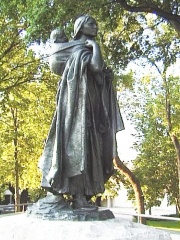
5. Sacagawea (1780 - 1812)
With an HPI of 67.01, Sacagawea is the 5th most famous American Explorer. Her biography has been translated into 48 different languages.
Sacagawea ( SAK-ə-jə-WEE-ə or sə-KOG-ə-WAY-ə; also spelled Sakakawea or Sacajawea; May c. 1788 – December 20, 1812) was a Lemhi Shoshone or Hidatsa woman who, in her teens, helped the Lewis and Clark Expedition in achieving their chartered mission objectives by exploring the Louisiana Territory. Sacagawea traveled with the expedition thousands of miles from North Dakota to the Pacific Ocean, helping to establish cultural contacts with Native American people and contributing to the expedition's knowledge of natural history in different regions. The National American Woman Suffrage Association of the early 20th century adopted Sacagawea as a symbol of women's worth and independence, erecting several statues and plaques in her memory, and doing much to recount her accomplishments.

6. Calamity Jane (1852 - 1903)
With an HPI of 66.84, Calamity Jane is the 6th most famous American Explorer. Her biography has been translated into 33 different languages.
Martha Jane Canary (May 1, 1852 – August 1, 1903), better known as Calamity Jane, was an American frontierswoman, sharpshooter, and storyteller. In addition to many exploits, she was known for being an acquaintance of Wild Bill Hickok. Late in her life, she appeared in Buffalo Bill's Wild West show and at the 1901 Pan-American Exposition. She is said to have exhibited compassion to others, especially to the sick and needy. This facet of her character contrasted with her daredevil ways and helped to make her a celebrated frontier figure. She was also known for her habit of wearing men's attire.

7. Hugh Glass (1783 - 1833)
With an HPI of 66.73, Hugh Glass is the 7th most famous American Explorer. His biography has been translated into 27 different languages.
Hugh Glass (c. 1783 – 1833) was an American frontiersman, fur trapper, trader, hunter and explorer. He is best known for his story of survival and forgiveness after being left for dead by companions when he was mauled by a grizzly bear. No records exist regarding his origins but he is widely said to have been born in Pennsylvania to Scotch-Irish parents. Glass became an explorer of the watershed of the Upper Missouri River, in present-day Montana, the Dakotas, and the Platte River area of Nebraska. His life story has been the basis of two feature-length films: Man in the Wilderness (1971) and The Revenant (2015). They both portray the survival struggle of Glass who, after being abandoned by companions, crawled and stumbled 200 miles (320 km) to Fort Kiowa, South Dakota. Despite the story's popularity, its accuracy has been disputed. It was first recorded in 1825 in The Port Folio, a Philadelphia literary journal, as a literary piece and later picked up by various newspapers. Although originally published anonymously, it was later revealed to be the work of James Hall, brother of The Port Folio's editor. There is no writing from Hugh Glass himself to corroborate the tale's veracity, and even if true there were likely embellishments added over the years.

8. Michael Rockefeller (1938 - 1963)
With an HPI of 66.64, Michael Rockefeller is the 8th most famous American Explorer. His biography has been translated into 24 different languages.
Michael Clark Rockefeller (May 18, 1938; disappeared November 19, 1961) was an explorer and member of the Rockefeller family. He was a son of New York Governor and later U.S. Vice President Nelson Rockefeller, a grandson of American financier John D. Rockefeller Jr., and a great-grandson of Standard Oil co-founder John D. Rockefeller Sr. Rockefeller disappeared during an expedition in the Asmat region of southwestern Dutch New Guinea, which is now a part of the Indonesian province of South Papua, with conflicting views of his fate. Rockefeller's twin sister wrote in a 2012 memoir that she believes her brother drowned. In 2014, Carl Hoffman published a book that included details from the official inquest into the disappearance, in which villagers and tribal elders stated that Rockefeller had been killed and eaten, after swimming to shore in 1961. No remains of Rockefeller or physical proof of his death have been discovered.

9. Chris McCandless (1968 - 1992)
With an HPI of 66.63, Chris McCandless is the 9th most famous American Explorer. His biography has been translated into 35 different languages.
Christopher Johnson McCandless (; February 12, 1968 – c. August 1992), also known by his pseudonym "Alexander Supertramp", was an American adventurer who sought an increasingly nomadic lifestyle as he grew up. After graduating from Emory University in Georgia in 1990, McCandless traveled across North America and eventually hitchhiked to Alaska in April 1992. There, he entered the Alaskan bush with minimal supplies, hoping to live simply off the land. On the eastern bank of the Sushana River, McCandless found an abandoned bus, Fairbanks Bus 142, which he used as a makeshift shelter until his death. In September, his body, weighing only 67 pounds (30 kg), was found inside the bus by a hunter. McCandless's cause of death was officially ruled to be starvation, although the exact circumstances relating to his death remain the subject of some debate. In January 1993, Jon Krakauer published an article about McCandless in that month's issue of Outside magazine. Inspired by the details of McCandless's story, Krakauer wrote the biographical book Into the Wild, which was subsequently adapted into a 2007 film directed by Sean Penn, with Emile Hirsch portraying McCandless. That same year, McCandless became the subject of Ron Lamothe's documentary The Call of the Wild.
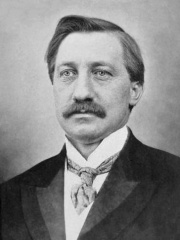
10. Frederick Cook (1865 - 1940)
With an HPI of 66.07, Frederick Cook is the 10th most famous American Explorer. His biography has been translated into 30 different languages.
Frederick Albert Cook (June 10, 1865 – August 5, 1940) was an American explorer, medical doctor and ethnographer, who is most known for allegedly being the first to reach the North Pole on April 21, 1908. A competing claim was made a year later by Robert Peary, though both men's accounts have since been fiercely disputed; in December 1909, after reviewing Cook's limited records, a commission of the University of Copenhagen ruled his claim unproven. Nonetheless, in 1911, Cook published a memoir of the expedition in which he maintained the veracity of his assertions. In addition, he also claimed to have been the first person to reach the summit of Denali (also known as Mount McKinley), the highest mountain in North America, a claim which has since been similarly discredited. Though he may not have achieved either Denali or the North Pole, his was the first and only expedition where a United States national discovered an Arctic island in North America, Meighen Island.
People
Pantheon has 39 people classified as American explorers born between 1734 and 1968. Of these 39, 2 (5.13%) of them are still alive today. The most famous living American explorers include Sue Hendrickson, and Ann Bancroft. The most famous deceased American explorers include Daniel Boone, William Clark, and Richard E. Byrd.
Living American Explorers
Go to all RankingsDeceased American Explorers
Go to all RankingsDaniel Boone
1734 - 1820
HPI: 73.46
William Clark
1770 - 1838
HPI: 72.67
Richard E. Byrd
1888 - 1957
HPI: 70.26
Davy Crockett
1786 - 1836
HPI: 67.86
Sacagawea
1780 - 1812
HPI: 67.01
Calamity Jane
1852 - 1903
HPI: 66.84
Hugh Glass
1783 - 1833
HPI: 66.73
Michael Rockefeller
1938 - 1963
HPI: 66.64
Chris McCandless
1968 - 1992
HPI: 66.63
Frederick Cook
1865 - 1940
HPI: 66.07
George W. De Long
1844 - 1881
HPI: 65.76
Simon Fraser
1776 - 1862
HPI: 63.12
Overlapping Lives
Which Explorers were alive at the same time? This visualization shows the lifespans of the 25 most globally memorable Explorers since 1700.

